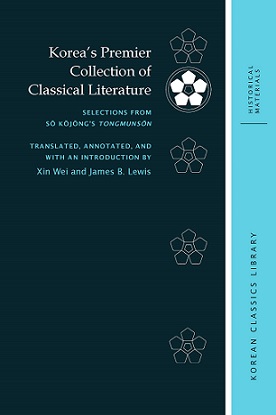-
2020 교육부 학술연구지원사업 우수성과: Korea’s Premier Collection of Classical Literature: Selections from Sŏ Kŏjŏng’s Tongmunsŏn.
-
Korea’s Premier Collection of Classical Literature: Selections from Sŏ Kŏjŏng’s Tongmunsŏn.
Translated, annotated, and with an introduction by Xin Wei and James B. Lewis.
University of Hawai’i Press, 2019

동문선은 19세기까지 제작된 한국의 문학작품 선집 중 그 양이 가장 방대하며, 역사적 의미 또한 지대한 문헌입니다. 그리고 본 저서는 그러한 동문선의 내용들을 영어로 널리 소개하려는 첫 노력에 해당합니다.
『동문선』은 조선 성종(재위 1469~1494)의 명에 따라 서거정(1420~1488)을 비롯한 여러 문신들이 중국의 저명한 선집인 『문선(文選)』을 모범 삼아 1478년에 편찬하였습니다. 본서는 그러한 동문선에 대한 상세하고도 분석적인 소개글과 함께, 논(論)과 설(說)이 수록된 『동문선』 96~99권에 대한 번역을 수록하였습니다. 본 저서 서두의 소개글은 우선 『동문선』의 전체 구조를 설명하고, 그에 실린 한국의 문학적 산물들을 8세기이래 15세기까지의 동아시아 문학의 맥락 속에서 조명하고 있습니다. 『동문선』에 수록된 작품 모두 한글이 아닌 한문으로 서술되었다는 사실 자체가 한반도와 대륙의 밀접한 문학적 관계를 보여주는데, 서론에서는 아울러 『동문선』에 수록된 문학작품들의 여러 갈래와, 그 운율에 녹아 있는 여러 문체 또한 소개하고 있습니다.
번역대상으로 선택된 『동문선』 4개권들의 논과 설은 과거 한국인들의 산문 집필방식 및 당시인들이 공유하던 문제의식을 잘 보여줍니다. 이규보, 이색, 이제현, 정도전을 비롯한 저명 작가들의 글에 나타난 도덕, 자연, 신비에 대한 논의들은 도교적, 불교적, 유교적 문제의식과 고민들을 노출합니다. 그런 글들을 번역함에 있어 본 저서는 상세한 주석은 물론 중국문헌 속 관련 문장들과의 비교 또한 풍부하게 제시하였습니다. 그런 점에서 본서는 중요 동아시아 문학작품 총서의 일부가 되기에 손색이 없다고 하겠습니다.
동문선의 모든 작품들은 저자가 아닌 문학 갈래별로 분류되어 있는데, 당시(15세기)의 편집자들은 저자의 명성이 아닌 작품의 문학적 영향력을 잣대로 수록할 작품들을 선정하였습니다. 이규보나 이제현의 글들 중에도 수록되지 않은 것들이 있음에서 그를 엿볼 수 있습니다. 물론 수록된 작품들 중 이규보의 것이 429개로 가장 많은 것은 사실이지만, 당시의 편집자들은 이규보의 작품 중에서도 동문선에 수록할 글을 엄선하였습니다. 그리고 동문선에 실린 작품들은 수정되지 않은 원 모습과 원래 순서대로 본서에 실렸습니다. 더욱 중요한 점은, 이 책에 실린 작품들이 고려와 조선 사이에 전개된 문학적 변화를 보여준다는 점입니다. 당대 부상하던 새로운 정통 사유체계로서의 ‘성리학’을 당시인들이 어떻게 고민하고 있었는지가, 수록된 작품들에 잘 나타나 있습니다.
This is the first book in English to offer an extensive introduction to Tongmunsŏn 東文選 (‘Selections of Refined Literature of Korea’)—the largest and most important literary collection of Korean poetry and prose created prior to the twentieth century. Tongmunsŏn was compiled in 1478 by Sŏ Kŏjŏng (1420–1488) and other Chosŏn literati at the command of King Sŏngjong (r. 1469–1494) and was modelled after the celebrated Chinese anthology Wen Xuan 文選. The translations showcase the intellectual concerns of the age. In addition to a detailed and analytical introduction, the book contains translations of books 96 through 99, the four books that collect all of two prose genres: treatises (non 論) and discourses (sŏl 說).
The Translators’ Introduction begins by describing the general structure of the Tongmunsŏn and contextualizes literary output in Korea within the great sweep of East Asian literature from the eighth to the fifteenth centuries. The entire Tongmunsŏn as well as all of the essays selected for translation were written in hanmun (as opposed to Korean vernacular), which points to a close literary connection between the continent and the peninsula. The Introduction goes on to discuss the genres contained in the Tongmunsŏn and examines style as revealed through prosody.
The translation of two of these genres (treatises and discourses) in four books of the Tongmunsŏn showcases prose-writing and the intellectual concerns of the age. Through their discussions of morality, nature, and the fantastic, we see Daoist, Buddhist, and Confucian themes at work in essays by some of Korea’s most distinguished writers, among them Yi Kyubo, Yi Saek, Yi Chehyŏn, and Chŏng Tojŏn. The translations also include annotations and extensive cross-references to classical allusions in the Chinese canon, making the present volume an essential addition to any East Asian literature collection.
All works in the collection, poetry and prose, were classified by literary genres, not authors, and the fifteenth-century compilers selected works according to the literary influence of the work itself and not the individual author. This is clear, because everything written by Yi Kyubo or Yi Chehyŏn was not included. Though it is true that Yi Kyubo had the largest number of works included in the Tongmunsŏn—namely 429—the compilers of that day were selective. The prose treatises and discourses are presented unmodified and in their order of inclusion. More importantly, though, these books were chosen to illustrate a moment of transition in Korean letters from Koryŏ to Chosŏn and reveal the best writers of the age examining themes essential to the coming orthodoxy, commonly referred to as Neo-Confucianism.
-
글쓴날 : [21-12-27 14:40]